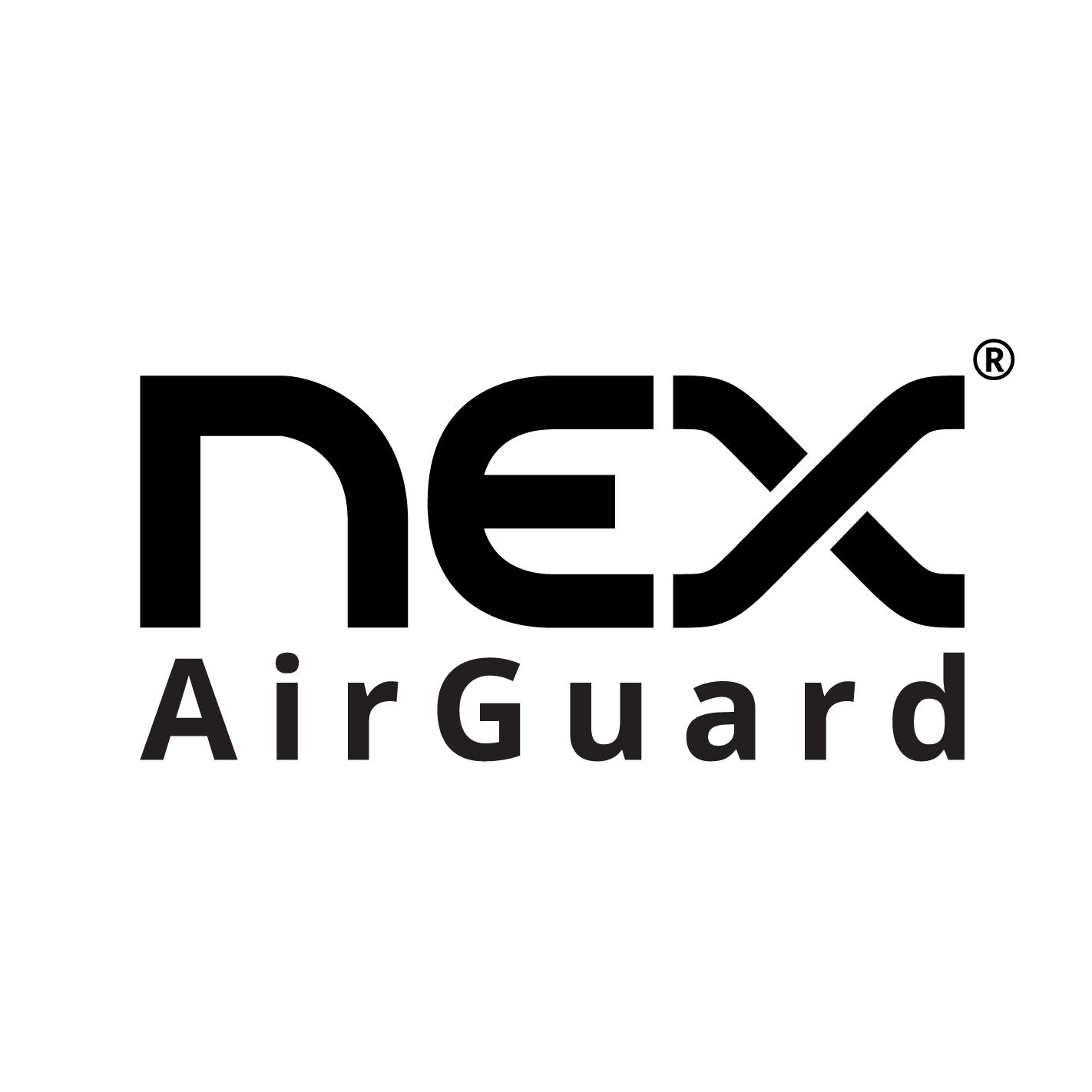NEX AirGuard : Air & Surface Disinfector and Purifier
Hydroxyl Ions Atmosphere’s Detergent
In the Troposphere, Hydroxyl Ions (OH-) are naturally occurring particles. Ultraviolet radiation from the sun breaks water vapor bonds in the atmosphere (thereby, ions can only be released outdoors where UV radiation is present). These ions are commonly referred to as the “Atmosphere’s Detergent” due to their ability to react with and break down numerous toxins and pollutants. They play a crucial role in removing greenhouse gases such as methane, ozone, fine particles (PM2.5), and various allergens. In addition, they eliminate pathogens and microorganisms such as viruses, bacteria, mold spores, and fungi by using the same natural protective mechanism as the earth’s atmosphere.
At present, various germs and pollution such as PM2.5 dust, Carbon Monoxide smoke that comes from burning various fuels, which will increase day by day which results in direct harm to humans Including the epidemic of Virus Covid19 that is still dangerous today.
NEX has therefore realized the importance of research and development of innovations for hygiene, good environment focusing on technology that creates clean air for safety in life, therefore, there is a policy for NEX’s engineering team to conduct research and development. Using advanced modern technology to apply
And from research and development for more than 10 years, with a research and development capital of over 100 million baht, we have developed and produced the Nex AirGuard innovation, which is a machine that creates Hydroxyl Ions (OH-) particles from MicroPlasma Bi-Polar Ionization technology. High efficiency in creating clean air Can destroy germs and various pollutants at the molecular level, including viruses, bacteria, fungi, musty odors, and pet odors. Smell from volatile chemicals various unwanted odors, dust PM 2.5 including various harmful pollutants both in the air and on various material surfaces that general air purifiers cannot eliminate.
Hydroxyl Ions
Hydroxyl Ions are the most important oxidizing agent in the Troposphere which is the lowest layer of the Earth atmosphere (0-10 km above the ground).
The properties of Hydroxyl Ions, which are a result of the greatest state of oxidation, allow them to bind to and oxidize nearby molecules, and neutralize unpair electrons. They react effectively with pollutants and pathogens both in the air and on the surface, hence, eliminating them. Hydroxyl Ions are called “Detergent of the atmosphere” by Paul J. Crutzen, who won the 1995 Nobel Prize in Chemistry. Our Earth atmosphere has a special self-cleaning feature by having small invisible molecules in the air working as detergents. The most important molecule in this category is Hydroxyl Ions.
Bipolar Ionization (BPI)
According to Einstein’s invention of fundamental atomic technology, a certain level of external energy is applied to break the molecular bonds of water vapor in the air and release Hydroxyl Ions (OH-). The unstable charged Hydroxyl Ion (OH-) will try to bond with Hydrogen Ions from other molecules, such as those of microorganisms, to form a new stable water molecule.
In the Troposphere, Hydroxyl Ions (OH-) are naturally occurring particles. Ultraviolet radiation from the sun breaks water vapor bonds in the atmosphere (thereby, ions can only be released outdoors where UV radiation is present). These ions are commonly referred to as the “Atmosphere’s Detergent” due to their ability to react with and break down numerous toxins and pollutants. They play a crucial role in removing greenhouse gases such as methane, ozone, fine particles (PM2.5), and various allergens. In addition, they eliminate pathogens and microorganisms such as viruses, bacteria, mold spores, and fungi by using the same natural protective mechanism as the earth’s atmosphere.
Using BPI technology, NEX’s engineering team has developed NEX AirGuard which generates Hydroxyl Ions (OH-) from the MicroPlasma Bipolar Ionization Technology. NEX AirGuard imitates a natural process to produce Hydroxyl Ions (OH-) indoors (without the presence of UV rays from the sun) by reacting with water vapor in the air. NEX AirGuard’s OH- ions can eliminate viruses, bacteria, and mold spores, as well as PM 2.5, without emitting ozone that is hazardous to humans and pets.
MicroPlasma Bi-Polar Ionization Techonology
Combining Bi-Polar Ionization Technology by Albert Einstein, Tesla coil (Electrical resonant transformer circuit) (1891) invented by Nikola Tesla, one of the greatest scientist, and recent Embedded system microprocessor, NEX’s engineering team has developed a new innovation to produce Hydroxyl Ions (OH-) from surrounding air.
The MicroPlasma Bi-Polar Ionization Technology in NEX AirGuard device functions to achieve good Indoor Air Quality (IAQ) that meets the World Health Organization (WHO) standard by reducing indoor air pollution, caused by the infiltration of external pollution, such as heated moving particles and gases, the chemical released by building material, cleaning agents, air sprays, the combustion particles from cooking and candles, the allergens from pets, the gases released by electronic devices and electrical appliances, etc. IAQ is around us and cannot be overlooked.
With MicroPlasma Bipolar Ionication, NEX AirGuard cause reactions to eliminate pathogens and VOCs as follows:
Reaction to microorganisms
– viruses
– bacteria
– fungi
– mold spores
Nex AirGuard produces Hydroxyl Ions with both positive charge (H+) and negative charge (OH-) from water vapor in the air. These ions surround hemagglutinin (proteins that bind microorganisms to receptors, such as the Spike Protein) and remove hydrogen (H2) from hemagglutinin’s molecule. The Hydroxyl Ions (OH-) then regroup with these hydrogens to form H2O (water vapor). This process disrupts the molecular structure of the microorganisms, deforming them, and ultimately eliminating or incapacitating the microorganisms upon entry into our bodies.
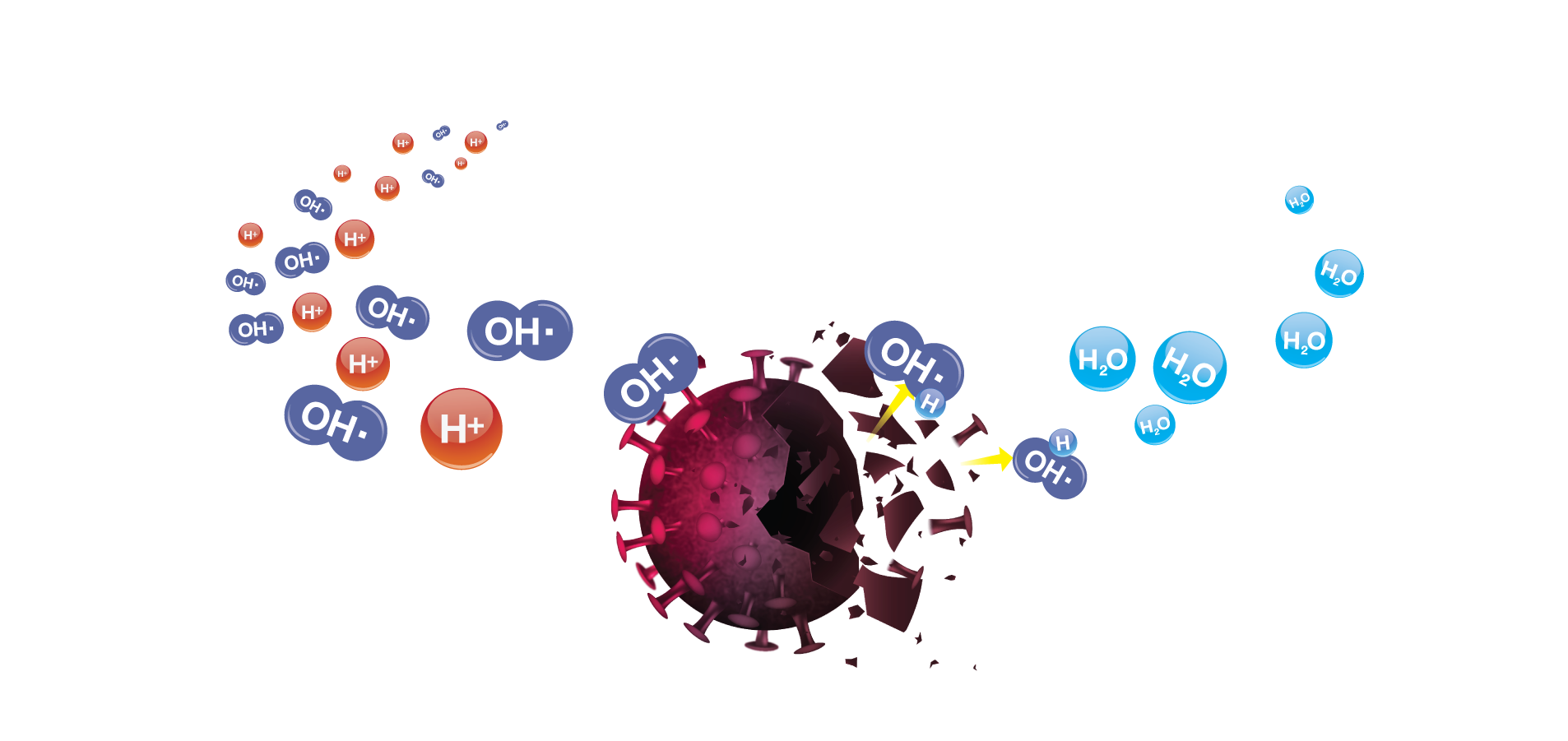 Bacteria
Hydroxyl Ions (OH-) surround bacteria and remove hydrogen from the cell wall to break down the bacterial cell and eventually destroy them.
Bacteria
Hydroxyl Ions (OH-) surround bacteria and remove hydrogen from the cell wall to break down the bacterial cell and eventually destroy them.
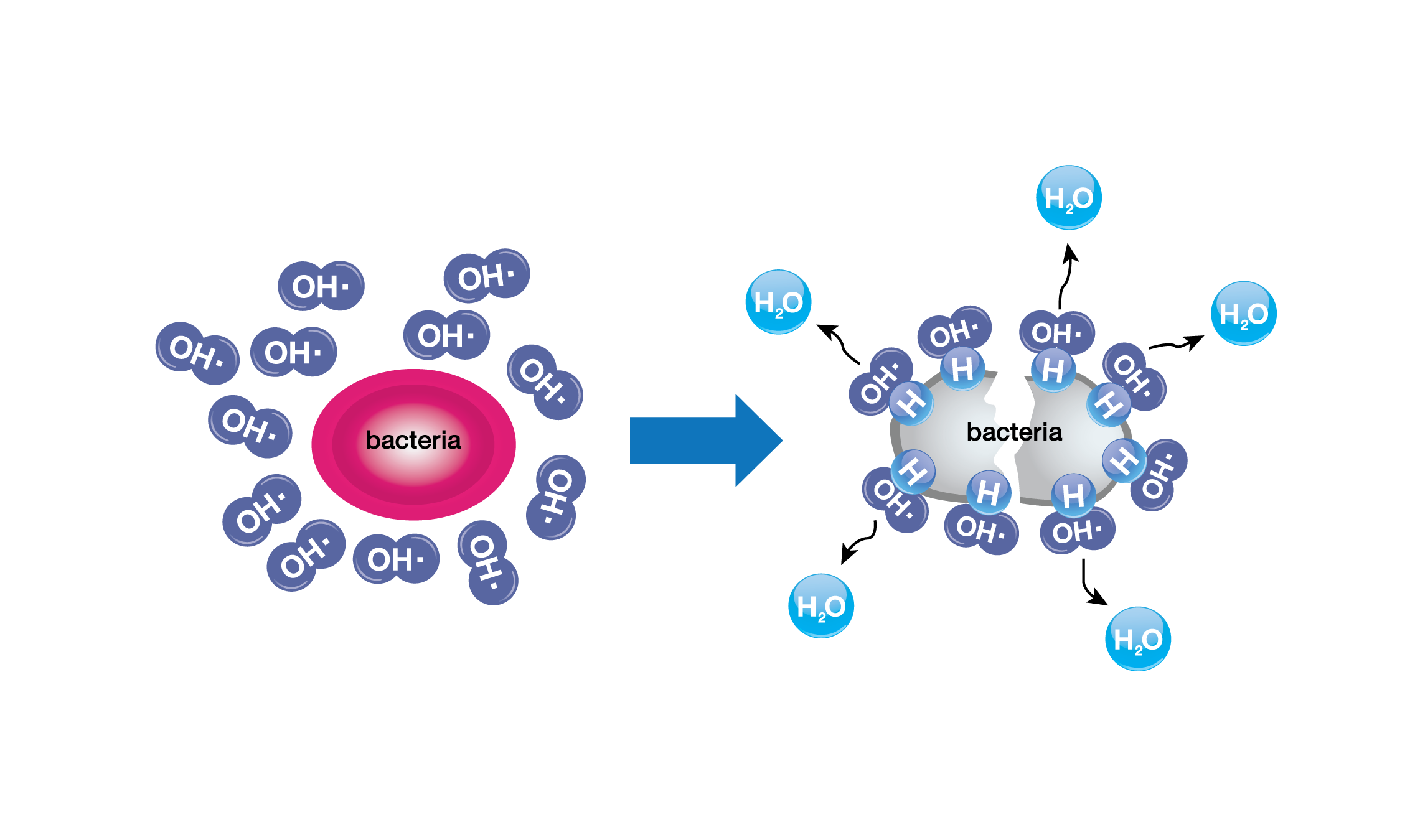 Fungal & Mold spores
Hydroxyl Ions (OH-) surround fungi and denature proteins on the fungal cell membrane by removing hydrogen; thus, killing the fungi.
Fungal & Mold spores
Hydroxyl Ions (OH-) surround fungi and denature proteins on the fungal cell membrane by removing hydrogen; thus, killing the fungi.
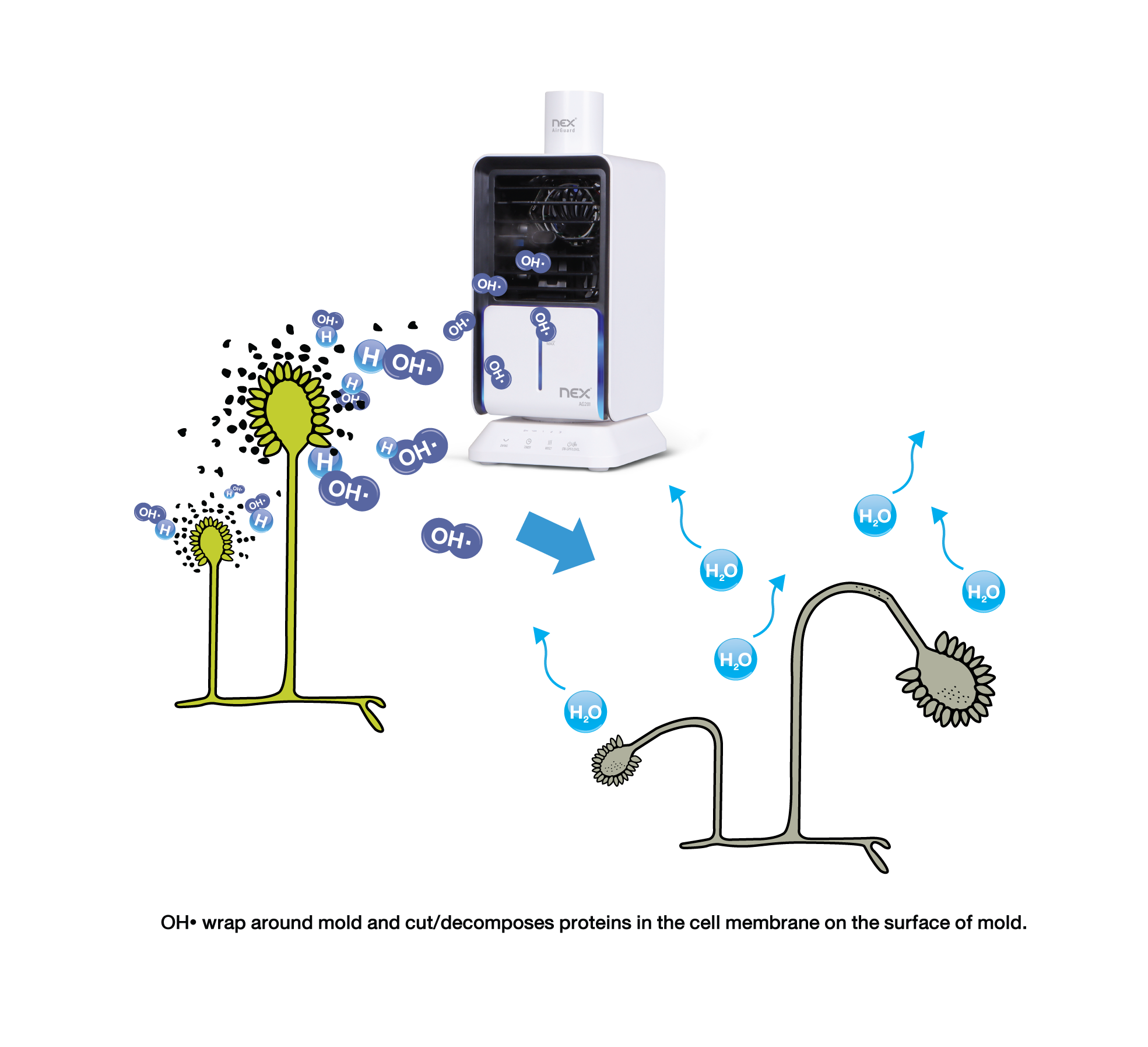 Reaction to Dust & PM 2.5:
Hydroxyl Ions (OH-) and Hydrogen Ions (H+) disperse throughout the area, combining with smoke or dust particles (PM 2.5) to form larger clusters that then fall to the ground.
Reaction to Dust & PM 2.5:
Hydroxyl Ions (OH-) and Hydrogen Ions (H+) disperse throughout the area, combining with smoke or dust particles (PM 2.5) to form larger clusters that then fall to the ground.
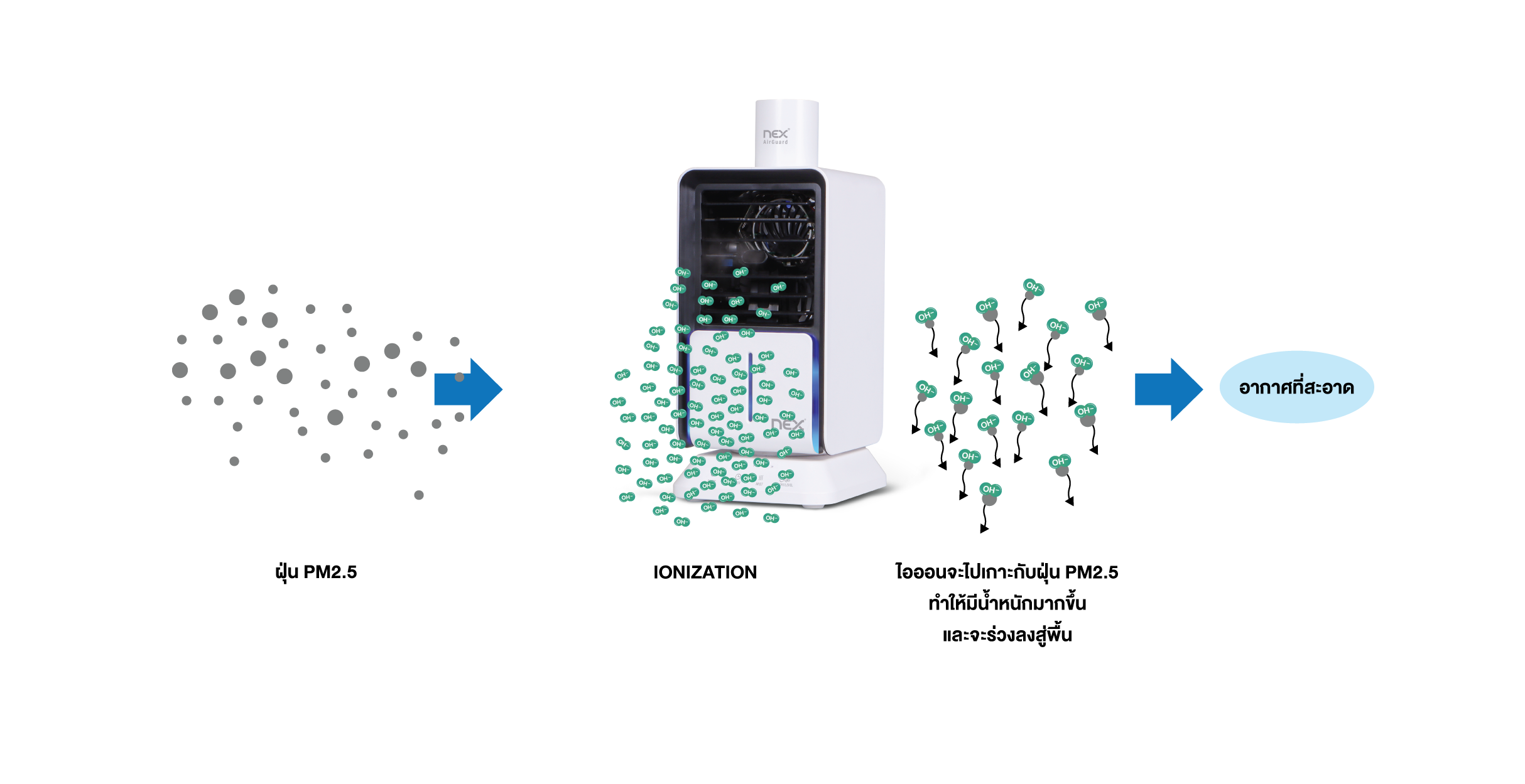 Reaction to Odor:
The vast majority of odors are caused by bacteria. Hydroxyl Ions (OH-) remove hydrogen from the bacterial cell wall, killing the bacteria. Once the bacteria are eliminated, the odor fades away.
Reaction to Odor:
The vast majority of odors are caused by bacteria. Hydroxyl Ions (OH-) remove hydrogen from the bacterial cell wall, killing the bacteria. Once the bacteria are eliminated, the odor fades away.
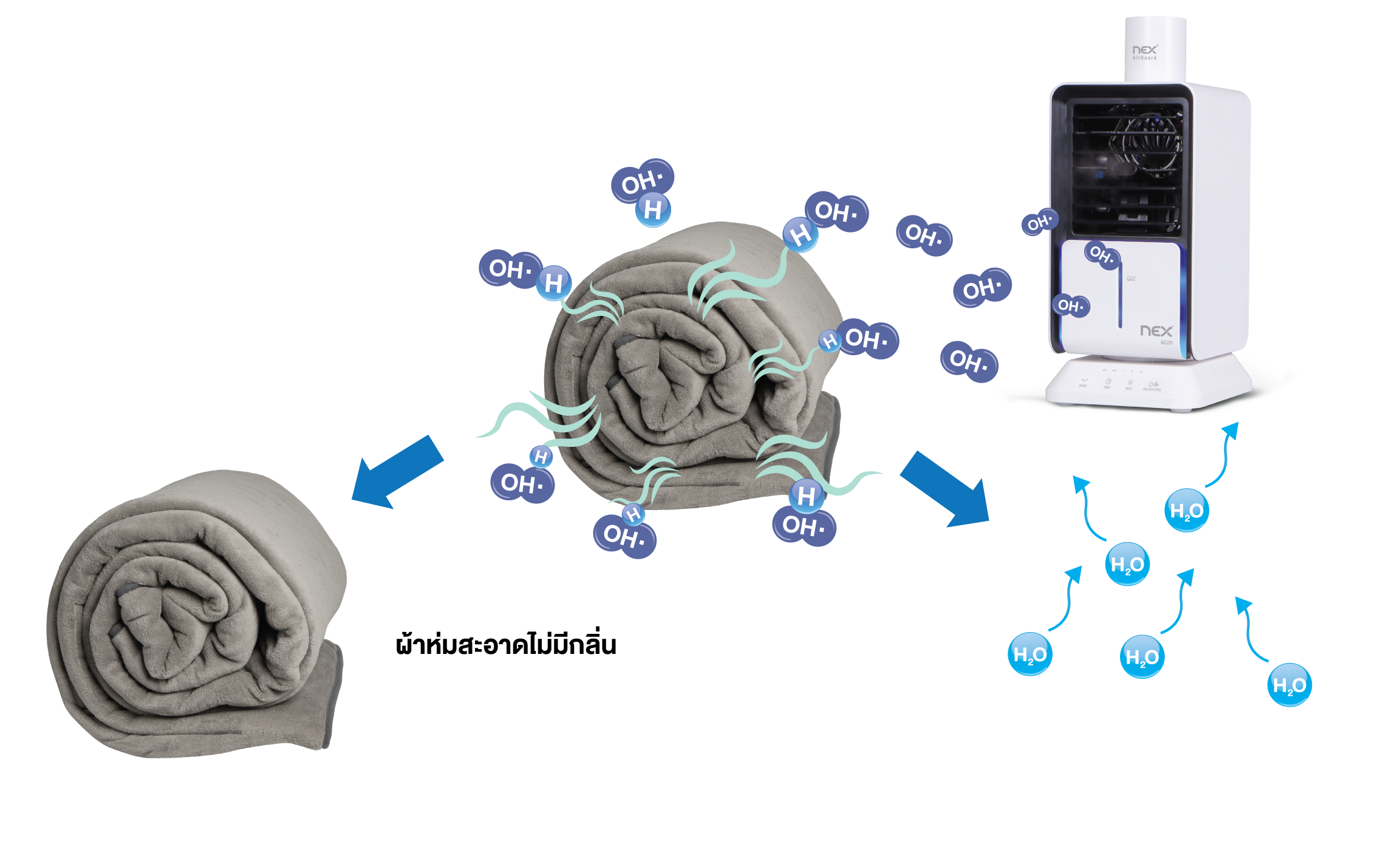 Reaction to Volatile Organic Compounds (VOCs) and VOC-induced Odor:
Hydroxyl Ions (OH-) oxidize volatile substances and pollutants, destroying their chemical bonds and changing their molecular structure. This process eliminates odors and converts them into natural molecules that are safe for humans and pets.
Reaction to Volatile Organic Compounds (VOCs) and VOC-induced Odor:
Hydroxyl Ions (OH-) oxidize volatile substances and pollutants, destroying their chemical bonds and changing their molecular structure. This process eliminates odors and converts them into natural molecules that are safe for humans and pets.
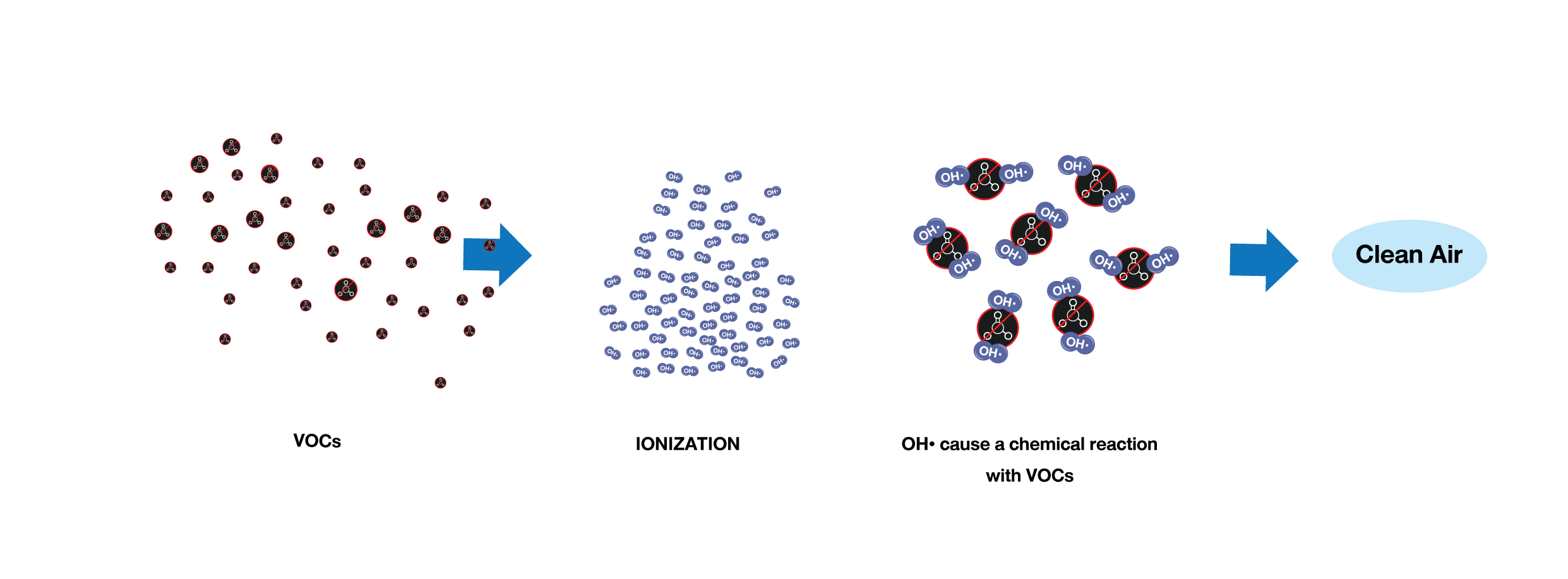 While there are many devices to trap microorganisms, some common methods, such as HEPA filters and ultraviolet (UV) lights, are examples of passive technology, in which the elimination or capture of undesirable microorganisms is only achievable if they pass through the equipment. Also, for a worse example, the use of UV light to produce ozone is hazardous to humans and pets. On the other hand, BPI is an active technology that disperses OH- to seek and destroy microorganisms before they can spread and cause harm to humans and pets.
Moreover, NEX AirGuard is known to reduce Carbon Dioxide level (CO2) in the area, as demonstrated by the equation: OH- + CO2 = HCO3. Hydroxyl Ions (OH-) combine with Carbon Dioxide (CO2) in the air to form Bi-Carbonate (HCO3-) (HCO3– is a negative ion found in cells and blood). As a consequence, it reduces the amount of carbon dioxide in the air without harming humans or pets.
Remarks: Bi-Carbonate (HCO3-) is also a negative ion. It is an inorganic compound that works as an electrolyte to balance the pH level of blood and body fluids.
While there are many devices to trap microorganisms, some common methods, such as HEPA filters and ultraviolet (UV) lights, are examples of passive technology, in which the elimination or capture of undesirable microorganisms is only achievable if they pass through the equipment. Also, for a worse example, the use of UV light to produce ozone is hazardous to humans and pets. On the other hand, BPI is an active technology that disperses OH- to seek and destroy microorganisms before they can spread and cause harm to humans and pets.
Moreover, NEX AirGuard is known to reduce Carbon Dioxide level (CO2) in the area, as demonstrated by the equation: OH- + CO2 = HCO3. Hydroxyl Ions (OH-) combine with Carbon Dioxide (CO2) in the air to form Bi-Carbonate (HCO3-) (HCO3– is a negative ion found in cells and blood). As a consequence, it reduces the amount of carbon dioxide in the air without harming humans or pets.
Remarks: Bi-Carbonate (HCO3-) is also a negative ion. It is an inorganic compound that works as an electrolyte to balance the pH level of blood and body fluids. 